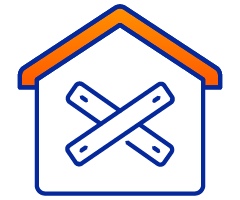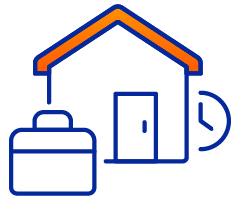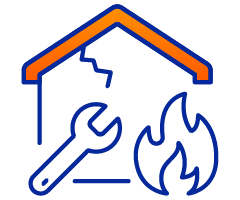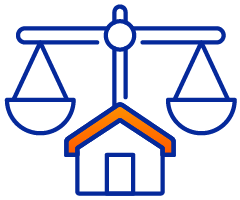Start Here
Homepage Bottom Form
We will get back to you as soon as possible.
Please try again later.
Home Fire Prevention & Safety Checklist
🧯 Home Fire Prevention & Safety Checklist
Created by House Fire Solutions – Protecting What Matters Most Before, During, and After a Fire
A house fire can start in seconds — and prevention starts with preparation.
This checklist covers
every major area of fire prevention, from smoke alarms to escape plans, so you can protect your home, family, and peace of mind.
🔥 1. Smoke Alarms & Detection Systems
Your first line of defense — install, test, and maintain regularly.
- Install smoke alarms on every level of your home, including inside bedrooms and hallways.
- Mount alarms on ceilings or high on walls, away from vents and windows.
- Choose interconnected alarms (when one sounds, they all do).
- Test smoke alarms once a month using the test button.
- Replace batteries every 6–12 months (set reminders with daylight savings).
- Replace entire smoke alarm units every 10 years.
- Install photoelectric and ionization sensors for broader coverage.
- Add strobe or vibration alarms if anyone in your household has hearing loss.
💡 Tip: Write the installation date on each alarm with a marker.
🔥 2. Fire Extinguishers
Quick action can prevent small fires from spreading.
- Keep at least one fire extinguisher on every floor.
- Store in high-risk areas: kitchen, garage, laundry room, and near exits.
- Make sure it’s rated ABC (for paper, grease, and electrical fires).
- Check pressure gauge monthly — needle should stay in the green zone.
- Ensure everyone in the home knows how to use it (PASS: Pull, Aim, Squeeze, Sweep).
- Refill or replace expired extinguishers immediately.
💡 Tip: Practice aiming at a safe target to build confidence — seconds matter.
🔌 3. Electrical Safety
Faulty wiring and overloaded circuits are among the top causes of home fires.
- Have a licensed electrician inspect your home every 3–5 years.
- Avoid overloading outlets or extension cords.
- Never plug space heaters or major appliances into power strips.
- Replace damaged cords or frayed wires immediately.
- Unplug small appliances when not in use.
- Avoid running cords under rugs or furniture.
- Install arc-fault circuit interrupters (AFCIs) and ground-fault circuit interrupters (GFCIs) where needed.
- Use only UL-certified electrical devices.
💡 Tip: Warm outlets or flickering lights are red flags — call an electrician ASAP.
🍳 4. Kitchen Fire Safety
Cooking fires are the #1 cause of home fires — simple habits save lives.
- Never leave cooking unattended.
- Keep oven mitts, towels, and paper products away from burners.
- Turn pot handles inward to prevent spills.
- Keep a lid nearby to smother grease fires.
- Never use water on a grease fire — use baking soda or a fire extinguisher.
- Clean stove tops, ovens, and range hoods regularly to prevent grease buildup.
- Unplug small appliances after use.
- Keep children and pets at least 3 feet away from the cooking area.
💡 Tip: Install a stovetop fire suppression canister for automatic extinguishing.
🕯️ 5. Heating Equipment & Fireplace Safety
Winter months bring higher fire risk — use heat wisely.
- Have chimneys and vents cleaned annually by a certified professional.
- Keep flammable items at least 3 feet from space heaters.
- Use only approved fuel sources (no gasoline or kerosene indoors).
- Turn heaters off when leaving a room or going to bed.
- Use a sturdy screen in front of fireplaces to prevent sparks.
- Dispose of ashes only when completely cool, in a metal container.
- Inspect furnace filters and dryer vents monthly.
💡 Tip: Plug space heaters directly into walls, never extension cords.
🧺 6. Laundry Room & Dryer Safety
Lint is one of the most common hidden fire hazards.
- Clean the lint filter before and after each load.
- Inspect and clean dryer vents every 6 months.
- Use only rigid or semi-rigid venting, not plastic.
- Keep the dryer area clear of clutter and chemicals.
- Never leave the dryer running when leaving home or sleeping.
- Ensure proper outdoor venting — not into attics or crawl spaces.
💡 Tip: A burning smell or slow drying could mean lint buildup — clean immediately.
🕯️ 7. Candles, Smoking, and Open Flames
Small flames are beautiful — but dangerous if left unattended.
- Blow out candles before leaving a room or going to bed.
- Keep candles 12 inches away from anything flammable.
- Use battery-operated flameless candles instead.
- Smoke outside only — use deep, sturdy ashtrays.
- Never smoke in bed or near medical oxygen.
- Extinguish incense and matches completely before disposal.
💡 Tip: One candle left burning overnight can destroy an entire room — always double-check.
🧰 8. Garage & Workshop Fire Safety
Garages often store the most flammable materials.
- Store gasoline, propane, and paints in approved metal containers.
- Keep combustibles away from heat sources or pilot lights.
- Unplug power tools when not in use.
- Sweep up sawdust and debris regularly.
- Install a smoke alarm (rated for garage temperatures).
- Avoid charging lithium-ion batteries unattended.
💡 Tip: Consider a heat detector instead of a standard smoke alarm — better suited for garages.
🧒 9. Family & Child Safety Education
Teach, practice, and make safety a habit for everyone.
- Show kids what smoke alarms sound like.
- Practice “stop, drop, and roll.”
- Teach kids how to crawl low under smoke.
- Assign a meeting spot outside the home.
- Keep matches and lighters out of reach.
- Review emergency contacts and 911 basics.
💡 Tip: Make fire safety a family game — reward good safety habits.
🗺️ 10. Escape Plan & Emergency Preparation
A plan only works if it’s practiced.
- Create a two-exit escape route from every room.
- Practice fire drills twice a year (day and night).
- Ensure all windows and doors open easily.
- Designate a meeting point outside.
- Keep flashlights and a first aid kit in key areas.
- Store important documents in a fireproof safe.
- Know where your main gas, power, and water shutoffs are located.
💡 Tip: Keep an emergency “Go Bag” ready with IDs, meds, and essentials.
🧯 11. Fireproofing & Prevention Upgrades
Take extra steps for long-term protection.
- Install fire-resistant materials (roofing, siding, drywall).
- Use flame-retardant sprays on curtains and furniture.
- Clear dead plants, leaves, and debris around your home.
- Create a defensible zone of at least 30 feet around the property (especially in wildfire areas).
- Use metal mesh screens to block embers from vents.
💡 Tip: Fire prevention upgrades often qualify for insurance discounts.
📋 12. Annual Fire Safety Review
Keep a yearly schedule to maintain all systems.
- January – Test smoke and CO alarms.
- March – Inspect wiring and outlets.
- May – Clean dryer vents.
- July – Clear vegetation and outdoor debris.
- September – Check fire extinguishers.
- November – Review escape plan before holidays.
💡 Tip: Add reminders to your phone or calendar — consistency saves lives.
❤️ Final Reminder
Fire safety isn’t a one-time task — it’s a
lifestyle of awareness.
Even small habits — unplugging devices, cleaning vents, testing alarms — make the difference between
disaster and prevention.
Stay ready. Stay safe.
House Fire Solutions
— Here for You Before, During, and After the Fire.
Our Team Helps You Navigate Insurance, Restoration, and Rebuilding
It is a long established fact that a reader will be distracted by the readable content of a page when looking at its layout.

Board-Up
Our Network of Board Up Specialist Will Secure your property fast

Temp Housing
We'll Help You Find Safe Shelter while you recover

Public Adjusters
Our Network of Fire Damage Adjusters Will Fight Help for a fair insurance payout

Investors
Our Partner Specializes in Buying Fire Damaged Homes So you Can Sell your home as-is

Content Cleaning
Restore what matters most

Restoration
Bring your home back to life

Attorneys
We have a network of Protect your rights and claims

Mental Health
Support for you and your family
Want To See If We Can Help You
If you'd like to speak with us today about purchasing Social Security, Personal Injury, Workers' Compensation or Employment Law Leads.
Homepage Bottom Form
We will get back to you as soon as possible.
Please try again later.